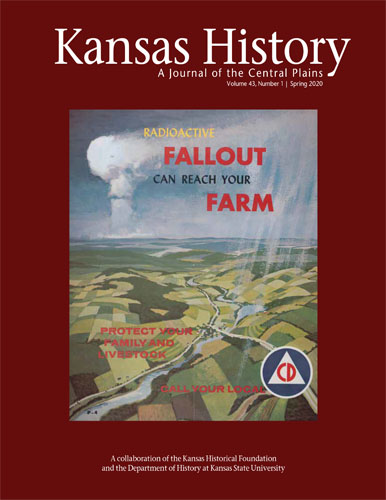May 20, 2020
Spring issue of Kansas History available now

The spring 2020 issue of Kansas History: A Journal of the Central Plains, Volume 43, No. 1, is now available. The journal is published quarterly through a partnership between the Kansas Historical Foundation and the Department of History here at K-State.
Articles in the new issue include:
Keith Wondra, "Hell After Sundown? The Image and Identity of West Wichita."
Throughout Wichita's history, a myth has grown that West Wichita or Delano contained all of the Old West rowdiness that included saloons and gambling and violence. Although Delano/West Wichita has long had the reputation as the center of vice as opposed to the more respectable east side of Wichita, as historian Keith Wondra demonstrates, the actual story is more complicated. Even during the heyday of the cattle years, the area west of the Arkansas River was not as rowdy as its reputation suggested; nor was Wichita proper as respectable. "Hell After Sundown" also highlights the challenge faced by a place such Wichita, which has both shunned its Cowtown Wild West image and at the same time embraced it as a form of local color. In the 1990s, the myth inserted itself into Wichita tourism: the promotion of the Delano neighborhood emphasized the area's 1870s rowdy reputation, a misleading version of the neighborhood's history.
Landry Brewer, "Kansas Missiles: Central Kansas and the Nation's Cold War Nuclear Arsenal, 1959-1965."
Central Kansas played an integral role within the American Cold War nuclear arsenal in the early 1960s by housing Atlas F intercontinental ballistic missiles, or ICBMs. Twelve Atlas F ICBMs, each at a separate location within 40 miles of Schilling Air Force Base in Salina, were operated 24 hours a day, seven days a week by United States Air Force personnel. Building the missile sites required extensive construction that was both costly and dangerous. Millions of dollars were spent; lives were lost. Building these missile sites provided thousands of Kansans and others with jobs; more importantly, however, argues historian Landry Brewer, the missiles housed there supplemented the nation's nuclear arsenal that was designed to deter Soviet aggression and defend the nation if deterrence failed. The sites were built and the missiles operated during the Cold War's most dangerous years. In fact, the missiles became operational just before the most dangerous thirteen days of the 45-year conflict between the United States and the Soviet Union — the October 1962 Cuban Missile Crisis. "Kansas Missiles" examines the contribution that Central Kansas made to the nation's Cold War nuclear arsenal in building Atlas missile sites and housing intercontinental ballistic missiles — and the missiles' impact on the state — during this most dangerous time.
Jeffrey A. Marx, "'Jeshurun Grew Fat and Kicked': Another Look at the Touro and Leeser Kansas Colonies."
Bolstered by the Homestead Act of 1862, a small number of Eastern European Jewish immigrants established eight Jewish agricultural colonies in Kansas during the 1880s. All were short-lived, writes historian Jeffrey Marx, and most have left little traces of their formation, existence and ultimate dissolution. Utilizing recent digitization of Kansas periodicals and land patents, together with census, naturalization, and ship manifest records, it is now possible, by examining the histories of the individual settlers, to reconstruct the story of Leeser and Touro, two of the colonies. Contrary to the usual narratives that their failure was due to harsh weather, lack of farming skills, and miserable living conditions, these personal histories suggest that, paradoxically, it was economic success that led to their demise.
Megan Rohleder, "Collection Review: The Martha Farnsworth Collection and the Fight for Suffrage in One Kansan's Words," Kansas Historical Society.
Kansas has been home to many firsts for women. These include the country's first female mayor and the first all-female city council, both occurring in 1887. Women saw other gains during this period leading ultimately, in 1912, to Kansas ratifying the state constitution to allow most women the right to vote (ahead of the national movement). Martha Cordelia Van Orsdol Shaw Farnsworth not only experienced these activist decades, but recorded her thoughts about them as well in a set of 16 diaries that spanned the years 1882 to 1922. Seven scrapbooks are also included. Taken together, this collection reveals the day to day concerns of a Kansas woman while serving as a barometer of social changes taking place in Topeka at the turn of the 20th century.
